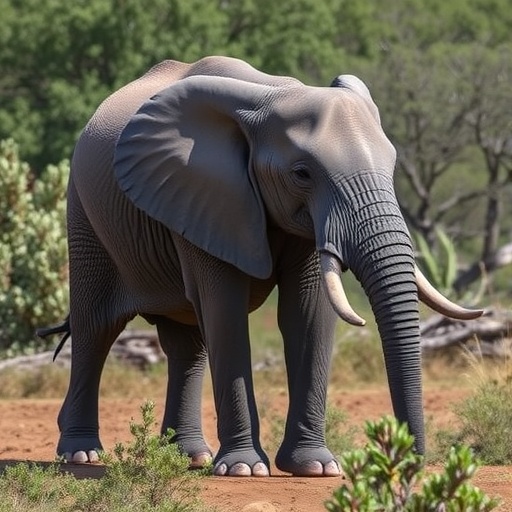In a recent scientific exchange that has captivated the ecological and genomic research communities worldwide, Rosen, van Vliet, and Foggin have published a compelling reply to a previous study investigating the 2020 mass die-off event among African elephants. This latest correspondence, published in Nature Communications, delves deeply into the genetic complexities that underpin one of the most catastrophic wildlife mortality events in recent history. Their analysis underscores the intricate interplay of environmental stressors, pathogen dynamics, and genetic susceptibility that collectively culminated in this unprecedented die-off, painting a nuanced picture that challenges prior interpretations and bolsters future conservation strategies.
The 2020 die-off event, which witnessed the sudden and large-scale mortality of African elephants, sent shockwaves through conservation circles and prompted urgent scientific inquiries. Given the ecological importance of elephants as keystone species, understanding the root causes of such mass mortality is critical. Earlier genomic studies suggested a specific pathogen-driven mechanism as the primary culprit. However, the reply by Rosen and colleagues introduces a more layered hypothesis emphasizing the role of genomic disparities within elephant populations, which may have heightened vulnerability to multifactorial environmental insults during that period.
Central to the authors’ argument is the integration of high-throughput genome sequencing technologies with advanced bioinformatic analyses. By reanalyzing genome-wide data from elephant carcasses collected during the die-off, Rosen et al. identified previously overlooked genomic variants associated with immune response genes. These variants signify potential adaptive or maladaptive responses to viral infections or environmental factors prevalent in the elephants’ habitats. The work draws attention to how subtle genetic differences can drastically influence individual and population-level resilience in the face of disease outbreaks.
This reply manuscript also critiques the initial conclusions of the earlier study, particularly regarding the attribution of cause based solely on pathogen detection. While pathogens were indeed a factor, Rosen and co-authors emphasize that genomic data reveal a far more multifaceted scenario. They argue that the genetic architecture of the elephant populations, shaped by evolutionary pressures and recent demographic changes, played a critical role in modulating susceptibility to infection and environmental challenges exacerbated by climate change and human activity.
One of the striking insights presented is the identification of specific genomic loci linked to inflammatory and antiviral pathways that were under selective pressure during the die-off event. These loci potentially hint at an evolutionary arms race between the elephants’ immune system and the pathogens they encountered. This finding lends support to the idea that conservation genomics must consider the dynamic genetic landscape of wildlife populations, particularly as they face novel threats in rapidly changing ecosystems.
Moreover, Rosen and colleagues underscore the influence of environmental stressors—such as drought, habitat fragmentation, and nutritional depletion—that might have synergistically interacted with pathogenic pressures. Their genomic analysis suggests that these stressors could have impaired immune function, rendering elephants more susceptible to the fatal disease outbreak. This integrative approach marks a significant advancement in understanding mass mortality events, moving beyond simplistic pathogen-centric explanations.
The reply also highlights the importance of genomic surveillance in wildlife health monitoring. By establishing genome-based biomarkers for susceptibility, future research can implement more predictive models to preempt outbreaks and design targeted interventions. This proactive paradigm represents a shift toward personalized conservation strategies that account for the genetic heterogeneity within endangered populations.
In discussing methodological approaches, the authors detail their use of cutting-edge sequencing technologies combined with machine-learning algorithms to parse the complex data sets. These tools enabled them to detect subtle genomic signatures and distinguish between genetic variants with functional relevance versus those that are neutral. This rigorous methodology sets a benchmark for future genomic studies aiming to elucidate the biological underpinnings of disease susceptibility in wildlife.
The reply from Rosen et al. also encourages a multidisciplinary collaboration framework, integrating genomics, ecology, veterinary science, and climate modeling. They argue that only through such holistic investigations can the diverse factors influencing wildlife health be comprehensively understood, ultimately informing sustainable conservation policies that mitigate similar mass die-off risks.
Furthermore, their detailed genomic investigation offers potential pathways for genomic-assisted breeding programs that increase genetic resilience in vulnerable elephant populations. Such interventions could become vital as conservationists grapple with the escalating threats posed by climate change and habitat encroachment, ensuring these iconic mammals endure for generations to come.
Importantly, the authors remind the scientific community that while genomics provides powerful insights, it is one piece of a complex puzzle. Comprehensive ecological data, longitudinal health monitoring, and continuous pathogen surveillance remain essential components of a robust conservation strategy. Integrating these approaches will enhance predictive capacities and enable rapid responses to emerging threats.
The implications of this work extend beyond African elephants, providing a blueprint for genomic investigations across diverse taxa experiencing unexplained mass mortality events. As wildlife populations worldwide face mounting pressures, the approaches outlined by Rosen and colleagues could revolutionize how conservation science detects, understands, and combats mortality crises.
In conclusion, the response from Rosen, van Vliet, and Foggin represents a significant milestone in conservation genomics. Their thorough genomic reassessment not only refutes oversimplified conclusions but also advances a sophisticated model where genetics, environment, and pathogens interact to shape survival outcomes. This research exemplifies the power of genomic science to unravel the mysteries of ecological disasters, offering hope for more effective intervention strategies to preserve biodiversity.
As this discourse unfolds, it is clear that the future of wildlife conservation will increasingly rely on genomics integrated with ecological and environmental sciences. The multi-dimensional insights provided by Rosen et al. set a precedent that can transform both our understanding and stewardship of vulnerable species in a rapidly changing world.
The mass die-off of African elephants in 2020 serves as a poignant reminder that conservation cannot rely on piecemeal approaches. Rather, it demands comprehensive, data-driven strategies informed by the latest advances in genomics and ecosystem science. The reply by Rosen and colleagues exemplifies this integrative approach, serving as a clarion call to the global scientific and conservation communities.
Subject of Research: Genomic analysis of the 2020 African elephant mass die-off event.
Article Title: Reply to: Genomic insights into the 2020 mass die-off event among African elephants.
Article References:
Rosen, L.E., van Vliet, A.H.M. & Foggin, C.M. Reply to: Genomic insights into the 2020 mass die-off event among African elephants. Nat Commun 16, 8526 (2025). https://doi.org/10.1038/s41467-025-63447-6
Image Credits: AI Generated
Tags: African elephant die-off 2020conservation strategies for elephantsecological impact of elephant mortalityenvironmental stressors on wildlifegenetic susceptibility in wildlifegenomic analysis of elephantsgenomic disparities in elephant populationshigh-throughput genome sequencingkeystone species and ecosystem healthmultifactorial causes of animal die-offpathogen dynamics in elephantswildlife conservation research




